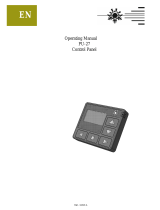Introduction
Volvo and the environment
* Option/accessory, for more information, see Introduction.
11
A sophisticated air quality system, IAQS*
(Interior Air Quality System) ensures that the
incoming air is cleaner than the air in the traf-
fic outside.
The system consists of an electronic sensor
and a carbon filter. The incoming air is moni-
tored continuously and if there is an increase
in the level of certain unhealthy gases such as
carbon monoxide then the air intake is
closed. Such a situation may arise in heavy
traffic, queues and tunnels for example.
The entry of nitrous oxides, ground-level
ozone and hydrocarbons is prevented by the
carbon filter.
Interior
The interior of a Volvo is designed to be plea-
sant and comfortable, even for people with
contact allergies and for asthma sufferers.
Extreme attention has been given to choosing
environmentally-compatible materials.
Volvo workshops and the environment
Regular maintenance creates the conditions
for a long service life and low fuel consump-
tion for your car. In this way you contribute to
a cleaner environment. When Volvo's work-
shops are entrusted with the service and
maintenance of your car it becomes part of
our system. Volvo makes clear demands
regarding the way in which our workshops
are designed in order to prevent spills and
discharges into the environment. Our work-
shop staff have the knowledge and the tools
required to guarantee good environmental
care.
Reducing environmental impact
You can easily help reduce environmental
impact - here are a few tips:
•
Avoid letting the engine idle - switch off
the engine when stationary for longer
periods. Pay attention to local regula-
tions.
•
Drive economically - think ahead.
•
Perform service and maintenance in
accordance with the owner's manual's
instructions - follow the Service and War-
ranty Booklet's recommended intervals.
•
If the car is equipped with an engine
block heater*, use it before starting from
cold - it improves starting capacity and
reduces wear in cold weather and the
engine reaches normal operating tem-
perature more quickly, which lowers con-
sumption and reduces emissions.
•
High speed increases consumption con-
siderably due to increased wind resis-
tance - a doubling of speed increases
wind resistance 4 times.
•
Always dispose of environmentally hazar-
dous waste, such as batteries and oils, in
an environmentally safe manner. Consult
a workshop in the event of uncertainty
about how this type of waste should be
discarded - an authorised Volvo work-
shop is recommended.
Following this advice can save money, the
planet's resources are saved, and the car's
durability is extended. For more information
and further advice, see the pages 208, 296
and 398.
Recycling
As a part of Volvo's environmental work, it is
important that the car is recycled in an envi-
ronmentally sound manner. Almost all of the
car can be recycled. The last owner of the car
is therefore requested to contact a dealer for
referral to a certified/approved recycling
facility.
The owner's manual and the
environment
The Forest Stewardship Council
®
symbol
shows that the paper pulp in this publication
comes from FSC
®
certified forests or other
controlled sources.























